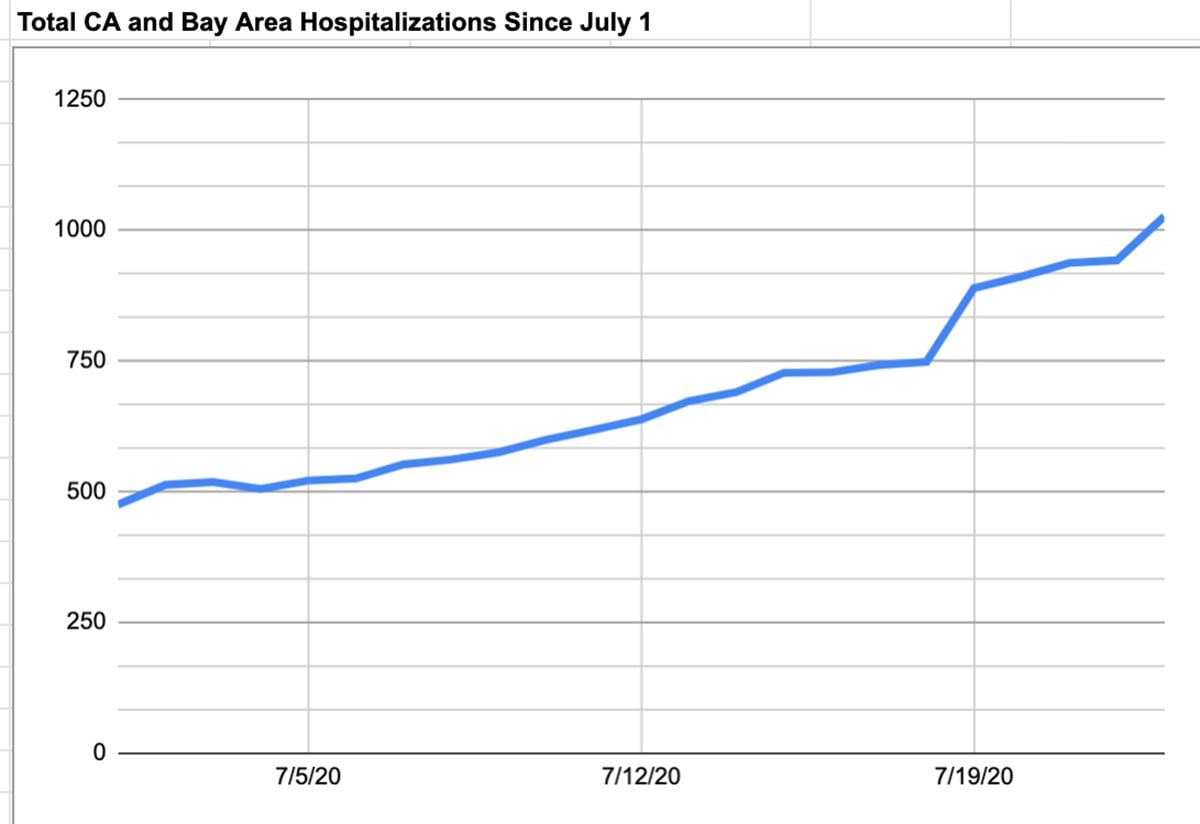With most of the data in for the nine counties in the Bay Area, this has officially been the worst week to date in this pandemic for COVID hospitalizations in the region, and likely the deadliest.
San Francisco recorded 115 new confirmed cases Friday, a 2.1-percent uptick, and 8 more people are hospitalized with confirmed or suspected cases than were in hospitals on Sunday — a total of 114, according to data submitted to the state. 477 new cases have been added in the city over the course of this week, and deaths have ticked up slightly as well — after no new deaths for three weeks beginning in mid-June, there have been six new deaths in SF since the first week of July.
The broader picture in the Bay Area over the past five days is more grim. There have been 54 new deaths recorded since Sunday, making this the deadliest week of the pandemic in the nine-county region since early April, and potentially the deadliest once Solano county's numbers are in. And at least 170 new COVID patients have needed hospitalizations in the Bay Area, bringing us the highest total of concurrent hospitalizations since the pandemic began: 1,008. Without knowing how many patients were discharged, but knowing that 54 have died, that means at least 170 new severe cases have appeared in the Bay Area this week.
In terms of new hospitalizations, the Bay Area is now outpacing the state of California, with the state seeing an average daily rise in new patients this week of 0.2 percent, while the Bay Area has seen a 6.7-percent average uptick each day (today's is 7% and counting, with at least 66 new sick patients).

The Bay Area has also added over 5,600 new cases since Sunday — with an average of around 900 new cases per day, that is more than double the rate seen in mid-June, which was around 390 cases per day, as the Chronicle notes.
The East Bay counties of Alameda and Contra Costa have together added around 500 new cases per day for several days running. And Santa Clara County added nearly 300 new cases on Wednesday.
The state as a whole set a grim record high of 157 deaths in one day on Wednesday, and there were 154 more yesterday. Noting that grim tally on Twitter, Governor Gavin Newsom said, "We cannot afford to ignore [this virus], or simply hope it goes away. We have to take action." The state also saw over 12,800 new cases added over one 24-hour period.
As the Chronicle notes, state legislators continue to argue about how to handle the pandemic fight and how better to contain the spread. State Senator Steve Glazer (D-Orinda) is pushing for a full reversal of course, and telling people to stay home again except for essential trips.
"It’s clear that we have lost control of the coronavirus fight," he said at a news conference Thursday. "You don’t have to look very far to see it in the numbers."
Still, while cases are surging in many counties in California, the scope and severity of the surge still seems to be less than what cities in Texas and Florida have seen during the same few weeks, and less than New York saw in March and April.
California, which has 20 million more residents than New York State's 19.5 million, just surpassed New York for cumulative cases, with over 430,000 cases as of Friday compared to NY's 414,000 — and many have been quick to point out this week that New York's per-capita case count is still far higher (almost double) given the population difference.
Dr. Bob Wachter, head of the Department of Medicine at UCSF, spoke to SFist late last week and said he was confident that San Francisco, and the Bay Area as a whole, was not likely in for an out-of-control surge. But we are seeing a moderate surge nonetheless.
As Dr. Wachter tells the Chronicle this week, there are now five known-effective therapies for severely ill patients — the anti-inflammatory steroid dexamethasone, Gilead's antiviral drug remdesivir, plasma therapy, proning (lying on the stomach), and intubation. "What we’ve seen now is demonstrably effective therapies that lower the probability that if you get sick that you will die by about a third; and that’s since March," Wachter says.
Dr. Peter Chin-Hong, an infectious-disease specialist with UCSF, strikes a note of moderation in thinking about how the state should handle its upcoming health orders. As Dr. Chin-Hong tells the Chronicle, "We’ve done a lot since the initial shelter in place, so I think reviewing some of the things that we’ve done and the things that we can do better might be a better way of thinking about it, rather than saying, 'shelter in place for everybody' or 'no shelter in place.'"
Photo: Sam Goodgame
This post has been updated throughout with the latest county data.

